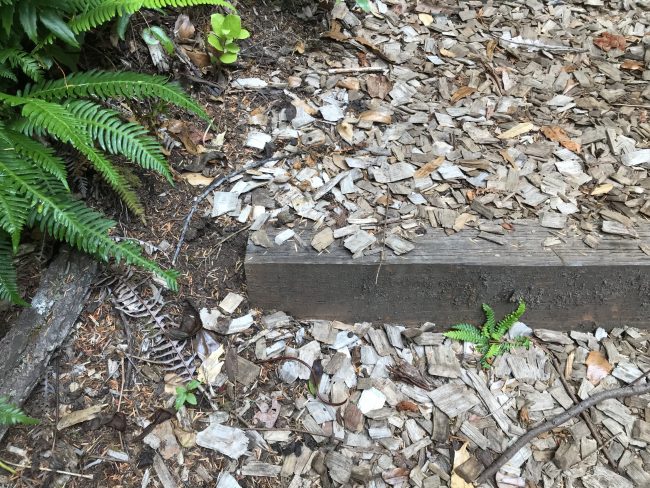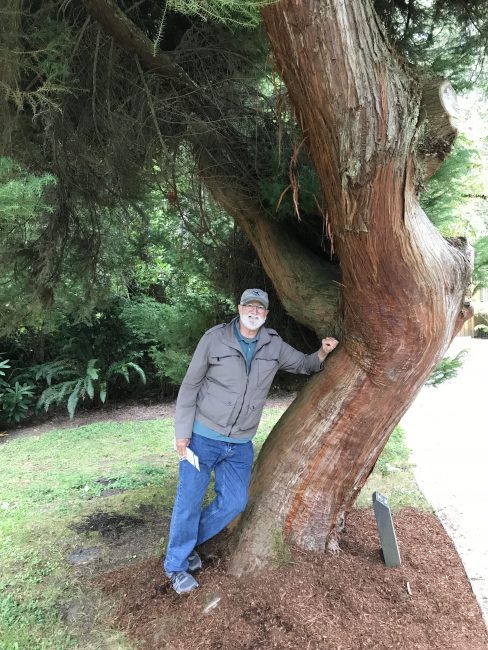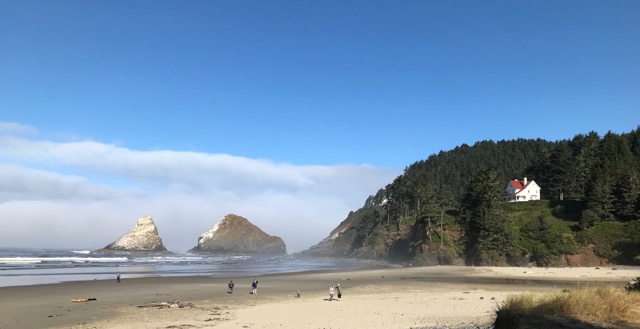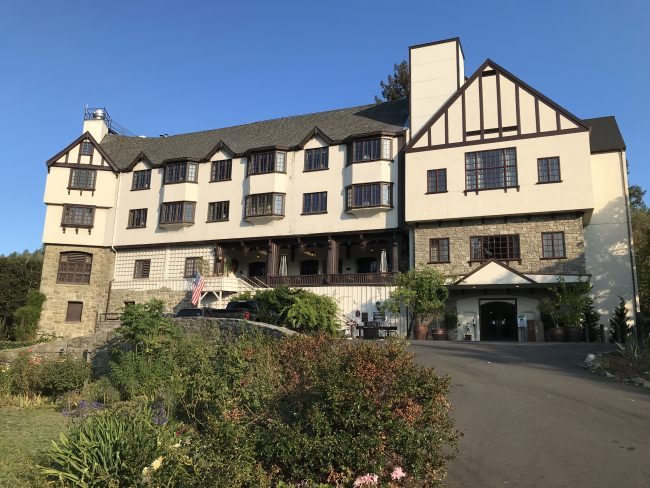COASTING THROUGH OREGON: A Senior Road Trip (August 31, 2021)

COASTING THROUGH OREGON: A Senior Road Trip (July 31, 2021)
During the second half of August, Nancy and I toured Oregon’s dramatic coastline, riding all the way on US101. With one trip we accomplished two objectives: escaping mid-summer heat and wildfire smoke in our San Francisco Bay Area and becoming better acquainted with a region we knew only superficially from prior drive-throughs. For two weeks we ventured out from basecamps in Yachats (“YA-hats”) on the central coast and Port Orford in the south. For this blog post, I’d like to share with you four trip components: an outward-bound adventure, key roadside attractions, overarching impressions and some reaffirmed travel lessons for seniors.
SLIP SLIDIN’ AWAY
To break our two-day drive north from California to Oregon, we selected Eureka, California as a handy mid-point layover. Checking in at hotel reception, I was startled by the all-caps notice propped on the counter:
WARNING!
IF YOU’RE DRIVING NORTH, US101 IS BLOCKED BY A LANDSLIDE,
2 MILES SOUTH OF CRESCENT CITY.
PASSENGER CARS ALLOWED THRU ONLY NOON TO 3PM DAILY.
GET THERE EARLY. THE LINES ARE LONG!
 We treated the change as a challenge, the curveball as an adventure. Before leaving Eureka, we loaded the car with snacks, hot lattes and bottled water. Even though we arrived at the barrier 90 minutes before noon, there were already hundreds of cars ahead of us in the queue. We chatted with the apologetic Caltrans flagmen and caught up on reading from our book sack. Two hours later, we were back underway.
We treated the change as a challenge, the curveball as an adventure. Before leaving Eureka, we loaded the car with snacks, hot lattes and bottled water. Even though we arrived at the barrier 90 minutes before noon, there were already hundreds of cars ahead of us in the queue. We chatted with the apologetic Caltrans flagmen and caught up on reading from our book sack. Two hours later, we were back underway.
My internet research revealed the roadblock’s intriguing backstory. This short stretch of US101 has been the site of so many landslides, it’s earned the nickname “Last-Chance Grade.” Some historians have counted no fewer than 200 active slides in the hundred-plus years since records were kept. The obvious remedy, rerouting the highway around the coastal problem-area, proves not to be so obvious. Due to the steep coastal range, treacherous soil conditions and surrounding federal and state redwood parks, a bypass would require a multi-mile loop costing billions of construction dollars. The current (unfunded) loop proposal projects completion no sooner than 2038! In the interim, periodic closures, clearances and slope-bracings remain the make-do strategy.
I’m happy to report this vignette’s ironic coda. Two weeks later, when we approached the slide’s northern edge on our homeward drive, a grinning yellow-jacketed flag-woman waved us through with only the briefest of pauses. “We’re working off-road today, so we don’t need to close the traffic lanes. You get a free pass!”
KEY ROADSIDE ATTRACTIONS
Heceta Heights
Lighthouses are always captivating: boldly sited, architecturally pristine, lingering relics of a once vital safety service. On this trip, our hands-down favorite was Heceta Head.
We swept down the narrow access lane from ridge-hugging US101 before two switchbacks propelled us out onto a secluded oceanfront cove. Soaring above to our left was a two-arched, 1930s bridge straddling Case Creek. To our right, up 200-foot cliffs, we marveled at the Lighthouse and Assistant Keeper’s house, pasted brilliantly white and red-roofed against the solid green of vertical vegetation. The hike up the hill was worth every step. The 1894 Lighthouse was surprisingly plain and modest in scale. But its beam is the strongest on the Oregon coast, shining 21 miles out to sea. The House is a two-story Victorian, now repurposed as a handsome B&B, with a gourmet chef and bookings a year in advance. The tiny gift shop, installed in the former kerosene-oil depot, displays historic photos of pre-highway buckboards racing through shallows around the head to beat the incoming tide. We were touched by the plaque on a vista bench. It commemorated a grandmother who’d collapsed and died on this site, surrounded by love at her granddaughter’s wedding. In the midst of life…
A Magical Glade
 In the morning mist, every leaf surface was audibly dripping. Through dense green panels of foliage, giant hydrangeas thrust neon-blue blooms. Mosses, fungi and ferns decorated tree roots. Rivulets tumbled down the steep slope. Nancy and I had these charmed woods to ourselves. Ten paces off 101, we had penetrated an encompassing rainforest. The four-acre Gerdemann Botanic Preserve was a miniature world.
In the morning mist, every leaf surface was audibly dripping. Through dense green panels of foliage, giant hydrangeas thrust neon-blue blooms. Mosses, fungi and ferns decorated tree roots. Rivulets tumbled down the steep slope. Nancy and I had these charmed woods to ourselves. Ten paces off 101, we had penetrated an encompassing rainforest. The four-acre Gerdemann Botanic Preserve was a miniature world.
James Gerdemann enjoyed a successful scientific and academic career as a University of Illinois plant pathologist. In 1981, he and wife Janice launched a retirement dream by nurturing and preserving a temperate rainforest in Yachats. The Central Coast climate was perfect. Annual rainfall of 100 inches was not exceptional. Indigenous species including spruce and hemlock, camellias and rhododendrons, were already flourishing on the plot. Although invasive-species opponents might shudder, the Gerdemanns supplemented local varieties with complementary rainforest specimens collected on worldwide expeditions over 30 years. New hybrids were propagated on-site. Today, the distinctive Preserve is maintained by a public-private conservation partnership. Its compact enchantment directly connects to the miles-long trails of Siuslaw National Forest.
In my April 30 blog post I recounted how acrimonious public-access litigation had long delayed Sea Ranch development on the northern California coast. We encountered an Oregonian analogy right outside the patio door of our Yachats hotel room. For decades, hiking enthusiasts have been struggling to connect and complete a Washington-to-California Coastal Trail, traversing Oregon’s entire 360-mile shoreline.
In Yachats, the battle between public-access champions and private-property owners has surged and ebbed for 50 years. Just north of town, a historical wagon route traced the cliff-edge, before descending to a wide sand beach and continuing to the next hamlet of Waldport. This County Road 804 right-of-way was resuscitated to provide the legal basis for trail advocates’ public-access demands decades after the road ceased active use. Interestingly, while affected landowners were consistently in opposition, public authorities – at town, county and state levels – flip-flopped between the contending sides over the years, perhaps in response to shifting political winds.
Now the trail offered Nancy and me repeated reminders of this scarred legacy. Bench plaques honoring resolute 804 proponents were interspersed with unambiguous “PRIVATE PROPERTY. KEEP OUT!” warnings on fences constraining the width of the pedestrian path. Litigants aside, the scenery was stupendous: crashing waves, the sprawling basalt bench, inviting tide pools, blackberries and honeysuckle, willow thickets and wind-trained conifers bent into arches. Mankind may be chronically combative, but Nature takes a longer view.
Storm Warriors
This was one of those roadside pauses that delivers exhilarating surprises. Knowing in advance that the Orford Head Lifesaving Station museum was closed by COVID, we drove up the hill from Port Orford town simply seeking a shaded picnic table. The parking lot gave no clues. Inching along a twisty path into a small clearing, we stumbled upon not only a quiet spot for our picnic but also an oasis of dramatic history.
 Signs explained that the closed museum had housed the lifesaving crew from 1934 to 1970. From this sheltered post, crewmen raced down 500 vertical steps to launch their emergency-rescue craft anchored in the cove directly below. The surviving lifeboat on proud display brought the diagrammed statistics alive. The 36-foot-long, all-wooden boats were self-righting and self-bailing. Only one had been lost in the station’s 35-years of operation. A crew of three to eight could fit in up to 24 rescued passengers. Hundreds of lives were saved, in some of the worst sea conditions in the world. (Cape Blanco five miles up the coast has recorded wind speeds of 187 miles per hour.)
Signs explained that the closed museum had housed the lifesaving crew from 1934 to 1970. From this sheltered post, crewmen raced down 500 vertical steps to launch their emergency-rescue craft anchored in the cove directly below. The surviving lifeboat on proud display brought the diagrammed statistics alive. The 36-foot-long, all-wooden boats were self-righting and self-bailing. Only one had been lost in the station’s 35-years of operation. A crew of three to eight could fit in up to 24 rescued passengers. Hundreds of lives were saved, in some of the worst sea conditions in the world. (Cape Blanco five miles up the coast has recorded wind speeds of 187 miles per hour.)
In their photos, the intrepid Storm Warriors look more like fresh-faced teens than Hollywood heroes. The commemorative display lauded “unsinkable boats, unstoppable crews.” We were more moved by the warriors own acerbic motto: “You have to go out. You don’t have to come back.”
Like thousands of other immigrants landing in San Francisco (then Yerba Buena) in the 1850s, Patrick Hughes was mad to seek his fortune panning for gold. His new bride, Jane, had a cooler head. Why not make their start in the New World doing something they already knew about from their Irish homeland – dairy farming? Common sense prevailed and the young couple started carving a homestead from scratch up the coast near Cape Blanco, Oregon. Perseverance was the Hughes’ middle name. Over the next 50 years, the couple and their expanding flock of seven children built a dairy empire. On a farm eventually extending to 2,000 acres of fertile river-bottom land, they produced cheese and butter for shipment to San Francisco markets 450 miles to the south, on their own fleet of coastal freighters.
Their handsome Queen Anne farmhouse, completed in 1899 and now recognized on the National Register of Historic Places, commands a stunning vista stretching across the Sixes River and rolling hills to the Pacific surf. In the surviving cemetery of their since demolished parish church, St. Mary’s by the Sea, a row of headstones remembers a half-dozen fellow immigrants who followed the pioneers to work on the Hughes estate. From County Cork, every one.
The Cape Arago Road
One of many visionary qualities to admire in Oregon is the State Government’s prescience in preserving their scenic wonders. Starting in 1967, the authorities began purchasing and preserving outstanding features of their 360-mile coastline. Today, no fewer than 80 State Parks are the legacy. We cruised along one five-mile stretch of coastal road hosting three distinctive examples.
 At Sunset Bay, hundreds of hardy locals frolicked on the beach, oblivious to the 50-degree temperature and swirling fog. Young couples with toddlers, elders with deck chairs, students playing ball games, dogs of every size and disposition. The boldest souls inflated and launched paddleboards and kayaks. As we shivered and marveled, the natives’ shared mood was palpable: how marvelous to be out of doors!
At Sunset Bay, hundreds of hardy locals frolicked on the beach, oblivious to the 50-degree temperature and swirling fog. Young couples with toddlers, elders with deck chairs, students playing ball games, dogs of every size and disposition. The boldest souls inflated and launched paddleboards and kayaks. As we shivered and marveled, the natives’ shared mood was palpable: how marvelous to be out of doors!
Just down the road in South Shore State Park, the Government has preserved and opened to the public the cliff-top gardens of lumberman and ship-builder Louis Simpson. Laid out in 1900 when European formalism and Japanese lily ponds were fashionable inspirations, the gardens now feature soaring specimens of Monterey pines and cypresses, as well as rainbow-barked Japanese cedars. An afternoon wedding was winding down during our visit. Nonchalant deer grazed in the adjacent meadow, as if this were their private preserve.
Next along this north/south corridor came Cape Arago itself. Falling sharply into the white-capped Pacific, the headland offers unobstructed vistas for tens of miles. At Simpson Reef, a booming chorus of barks and roars issued from thousands of sea mammals just below. Hauling out on shelves and stacks, the menagerie was identified by naturalist diagrams as comprising California and Stellar sea lions, Harbor and Northern Elephant seals. In the spring, these beaches are sealed off from human intruders to afford safe space for pupping.
Rounding out this scrapbook of favorite sites, our return drive on the Redwood Highway featured an overnight stay at the Benbow Inn. This historical landmark near Garberville was an A-List magnet in its heyday. Inaugurated in 1926 to take advantage of the Highway’s opening, the 2,200-acre resort showcases riding stables, a golf course, fishing and boating on the adjacent Eel River, even its own landing strip. Herbert Hoover and Eleanor Roosevelt stayed over, along with Spencer Tracy, Clark Gable and Alan Ladd. The Great Depression squashed this remote oasis, mid-way between vineyard valleys and Pacific shores. Successions of investors tried without success to rekindle the flame.
Now, three stubborn partners think they’ve at last hammered out a winning business plan. A new wing completes the architect’s original design, only 90 years from drawings to dedication. ADA conformity enhances customer access. The managers admit softly that the cocktail bar praised by clients as courageous historical restoration is in fact a modern homage. Guestrooms combine period furnishings with high-speed internet access and firm queen beds. The dining terrace observes COVID table distancing and aims for a gourmet menu. (On a Monday evening, at least all tables were occupied.) Leasing land to an upscale KOA campground broadens the hotel’s marketing outreach and generates year-round cash-flow. This is an ambitious, multifaceted recovery agenda.
The Inn is a work in progress, with significant wrinkles still to be ironed out. The front lobby, crucial for first impressions, has yet to be upgraded to match the rest of the tasteful renovations. Locally hired staff haven’t mastered four-star hospitality. But this comeback is gathering steam. benbowinn.com.
LINKING THEMES
In addition to the specific roadside highlights, here are some overarching observations that influenced our entire vacation.
COVID’s Insidious Impact
The pandemic touched every community we passed through, with invisible damage often the most devastating.
Nancy and I were personally well-prepared and protected. We’d both had two doses of the Pfizer vaccine and no auto-immune vulnerabilities. We adopted careful roadside routines: constant hand-sanitizing, masking, social distancing, minimizing contact with indoor groups, maximizing use of take-out and drive-through food services. But we quickly learned how much coastal Oregon was suffering.
COVID has buffeted the regional economy with a triple whammy. First, 2020 lockdowns flattened tourist bookings. Next, chronic labor shortages prevented hospitality enterprises’ capacity to fully benefit from 2021’s early-summer rebound. Now, low vaccination rates are driving a Delta-variant surge that’s overwhelming medical services and facilities.
The resulting commercial depression is evident in nearly every enterprise in every town. Cafes are closed. Hotels apologize for no longer cleaning rooms during guests’ stays. Bed & Breakfasts have cancelled their magnet breakfasts. Public-sector tourism services have been uniformly scaled back. Local visitor centers, historical museums, guided State Park nature tours – all are indefinitely suspended.
This is not merely a public-health crisis. Protracted COVID shutdowns have triggered a pervasive and persistent labor shortage. “We’re Hiring!” signs pepper every storefront window. Our 58-room, top-rated Yachats hotel can’t fill 15 vacant full-time staff positions, despite generous remuneration packages including health insurance and retirement benefits. Informal conversations with local business owners, managers and employees confirm this paralysis is layered and not easily relieved. Formerly employed couples can’t afford to return to work so long as closed or reclosing schools keep their children at home. Lower-end workers used lockdowns to rethink the attraction of long daily commutes to scutwork jobs paying minimum wages. Restaurants and motels struggling to recover from 2020 revenue losses can’t or won’t boost wages to recruit unskilled employees.
Oregon’s coast is relatively remote. Its economic history has always been a sequence of booms and busts: fisheries and canning, logging and lumber, now tourism and hospitality services. The coming 12 months will reveal how the latest cycle plays out. Most entrepreneurs we spoke with are battened down to weather a storm.
Two Oregons
Almost all the Oregonians Nancy and I chatted with on this trip were warm and welcoming. But we also noticed signs of the same polarization in political values that is paralyzing national cooperation for problem-solving.
For example, one of our innkeepers was an outspoken progressive, furious that anti-vaxers were driving Delta’s surge in his area. “Portland and Eugene” were the cultures he identified with.
Yet in these same neighborhoods, the Roosevelt Highway named to commemorate Great Depression construction by the Civilian Conservation Corps has been officially re-designated “The Persian Gulf, Iraq & Afghanistan Veterans Memorial.” And a pickup truck parked next to us at a Scenic Wayside sported two unambiguous challenges on its rear panel: “Laugh, Love, Live. If that doesn’t work, Ready, Aim, Fire!” and “FUCK BIDEN! DON’T CALIFORNIA MY OREGON!”
The rural/urban chasm runs deep, right to the continent’s edge.
Chow Time
Nancy’s and my palettes have been spoiled by 15 years living and eating in Italy. Every back-roads Umbrian hilltown seemed to host a mom-and-pop trattoria offering delicious regional recipes based on locally sourced, seasonal ingredients.
On this trip and others, our American roadside dining experiences have almost all been comparatively disappointing. Even in highly touted, locally owned restaurants, we found that featured entrees were over-spiced or drowned in balsamic reductions.
Here are some cheering exceptions from our Oregon coastal rambles:
- Luna Sea Fish House in Seal Rocks looked down on its luck, with a weathered building and outdoor tables scattered around an unshaded parking lot. But owner Robert Anthony had been out fishing on Liberty II that same morning. My grilled Chinook salmon was the best dish of the trip.
- The Crazy Norwegians in Port Orford had a magical touch: a friendly staff politely but firmly enforcing COVID protocols; fresh, tasty fish and chips; and tempting home-baked cream pies.
- We were ignorant of Amy’s Café chain. Their inventive vegetarian drive-through menu and freshly squeezed ginger/mint lemonade were an uplifting remedy for burger boredom.
Meanwhile, in Yachats, neighborhood coffee bars tacitly reflected alternative lifestyles. Bread & Roses’ hand-lettered window sign succinctly apologized: “Sorry. Closed to clean the fish tank.” Across the road, The Green Salmon’s signage acknowledged local realities and defended its perimeter: “No camping on premises”; “No overnight loitering.”
SENIOR TRAVEL LESSONS REAFFIRMED
As we approach 80, Nancy and I retain our life-long zest for travelling but are making age-appropriate modifications. Here are some lessons we reaffirmed on our just-concluded Oregon excursion. While travel approaches and preferences are highly personal, you may find some ideas to consider in your own senior trip planning.
- Before starting out, we pledged to slow our pace, especially in terms of hours of daily driving. The temptation, as always, might be to reach our distant destination as quickly as possible by keeping going, mile after mile, with the two of us alternating behind the wheel. But we agreed that marathon driving would be stupid, not safe, an invitation to senior fatigue and flagging concentration at 70 miles per hour. Instead, we aimed for a daily driving schedule of no more than six hours on the road: four actually driving (with hourly changeovers between driver and navigator); plus two more spread out over rest stops and a restorative lunch break. Due to the landslide, we didn’t always adhere to this timetable. But most days, following this guideline improved the attentiveness of our driving and let us arrive unwilted.
- On the road, we recommitted to being travelers, not tourists. Making “getting there” as important as “being there.” As encountered at the Last-Chance Grade, we expected and accepted delays and detours as inevitable, aiming to exploit them for opportunities. In that same spirit of making traveling a valued part of the trip, we appreciated interactions with local folks as much as visiting historical landmarks.
- Speaking of landmarks, we pared our list of things to see. Quality, not quantity. One splendid site walked through beat six rushed through. So also, we deliberately built downtime into our daily travel schedule: staying still, recharging batteries, simply being instead of always doing.
- When doing that walking, and lots of it, we acknowledged our declining physical strength, stamina and balance. No more summit ascents or trails rated “Strenuous.” We chose shoes carefully and (almost always) remembered to carry maps and drinking water. Next time we promise to finally use our purchased trekking poles.
- We structured our itinerary around two week-long basecamps. Nightly packing and unpacking can make travel a disruptive blur. By selecting one Central-Coast and one South-Coast base, we could leisurely explore two zones without long-distance driving. (Despite thorough research, on this trip one base (overleaflodge.com) worked out much better than the other. The lesson I learned was to make sure that host-publicized industry awards and rave reviews are current.)
- We decided to invest in superior accommodations on the road, knowing this might require paying more than we were used to. We searched for exceptional lodgings, especially for week-long basecamps. Minimal requirements were convenient locations, cleanliness and safety, but we also reached for style and comfort. Both to boost on-the-road nutrition and reduce our COVID exposure, we made a special effort to secure accommodations with equipped kitchenettes.
- Nancy and I are coming to accept that most of our trips from now on will not be repeated. Even the enjoyable ones. We may live 10-20 more years, but only five of those years may be fully mobile. And we’re constantly adding to our wish-list of not-yet-visited priority destinations. This pragmatic recognition counsels making the most of each trip the first time around. Definitely not attempting to cram in every possible site or activity. But traveling selectively, attentively and gratefully. Another application of Agile Aging.
* * *
My sincere thanks to Nancy Swing for her evocative photos.
Coming September 30:
A COVID-POSTPONED 60TH HIGH-SCHOOL CLASS REUNION
And for October 31: “Taking the Right Turn”
When I invited essay contributions for my July 31 blog post on “Paths Not Taken,” some subscribers protested, only half in jest, “When I reached MY fork in the road, I took the RIGHT turn! It changed my life and I never looked back. Can I tell my story?”
So here’s your chance. Send me 300-400 words on your version of “Taking the Right Turn.” rbs@agileaging.net . By October 10, if you please.



